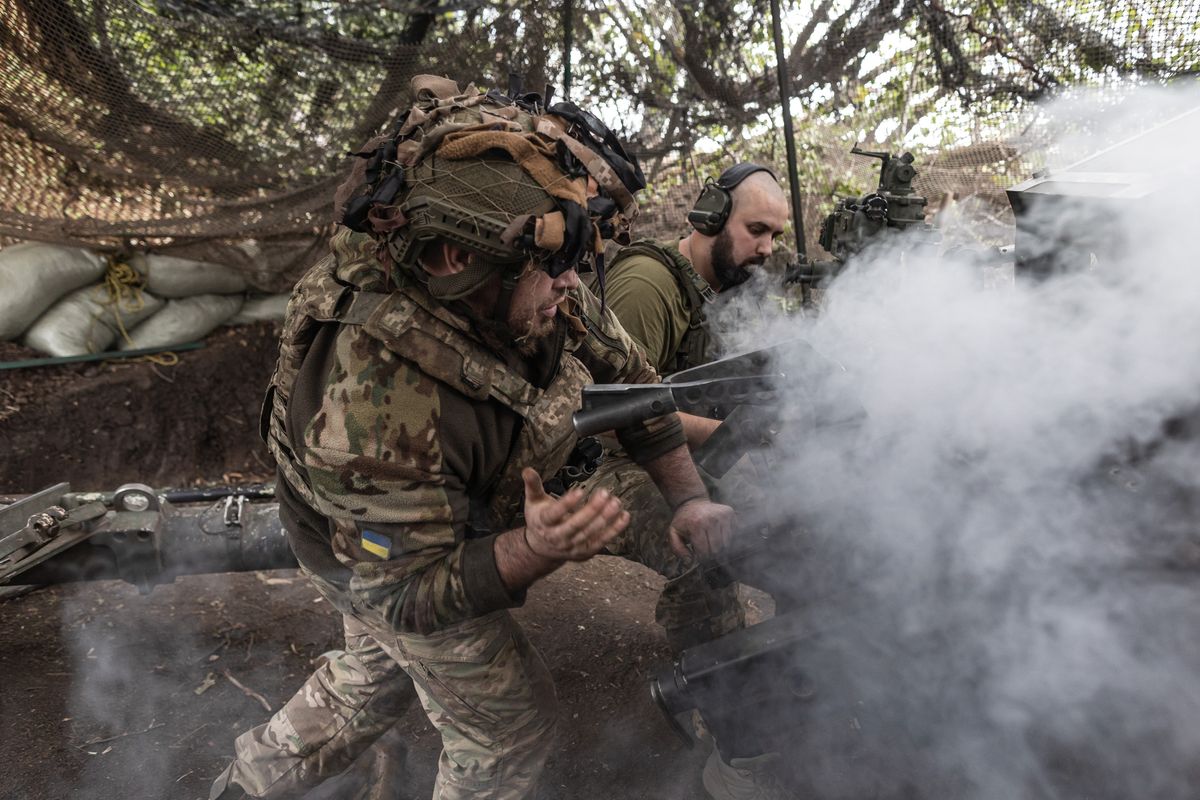OPINION -- “Since January 2024, Russian forces have seized approximately 5,000 square kilometers [1,931 square miles] of additional Ukrainian territory, less than one percent of the country. In certain areas, such as Kharkiv, Russia’s rate of advance is as little as 50 meters [55 yards] per day on average. These incremental gains have come at the cost of heavy losses. This quarter [April 1, 2025-to-June 30, 2025], Russian casualties in the Russia-Ukraine war likely surpassed one million, including approximately 250,000 killed and 750,000 wounded, missing, or captured. Russian fatalities during three years of war against Ukraine are 15 times greater than those experienced during the Soviet Union’s decade-long war in Afghanistan.”
That is an excerpt from the 120-page Special Inspector General for Operation Atlantic Resolve Quarterly Report to the United States Congress, required by a provision in the fiscal 2024 National Defense Authorization Act.
Released publicly August 12, 2025, the report [seventh in the series] summarized U.S. Government support to Ukraine and the broader response to Russia’s full-scale invasion, including support for the Ukrainian Armed Forces (UAF), support for NATO partners, and U.S. military, diplomatic, and humanitarian activity.
I found the report, done jointly by the acting-Inspectors General of the Defense Department (DoD), State Department (DoS) and Agency for International Development (AID) – which is now part of DoS, contained interesting facts and analyses about U.S., Ukrainian, Russian and NATO country activities that I had not read elsewhere.
For example, according to the report, “The conflict continued to be characterized by exchanges of artillery and UAS (unmanned aircraft systems) strikes. Since last quarter, Russia’s artillery fire rate increased from approximately 23,000 rounds per day to between 27,000 and 28,000 rounds per day. Russia increased its expenditure of one-way attack unmanned aerial vehicles (UAV) in one of its priority areas from 7,000 in April to 10,000 in May. The DIA (Defense Intelligence Agency) said that, extrapolating from this one area, it is possible that Russia is expending up to 72,000 tactical UAVs per month in roughly nine main operational areas.”
On the front lines, the report said, a “novel Russian tactic is using UAVs to deliver grenades filled with riot control agents, such as CS gas and Chloropicirin [a tear gas]…Russia deploys these UAVs to clear UAF (Ukraine Armed Forces) from entrenched fighting positions and into more open or vulnerable areas. While these chemical agents are not considered lethal, Russia uses them to shape the battlefield and cause UAF casualties.”
The Cipher Brief brings expert-level context to national and global security stories. It’s never been more important to understand what’s happening in the world. Upgrade your access to exclusive content by becoming a subscriber.
Another Russian tactic, according to the report, is “a consistent increase in Russia’s jamming of Global Navigation Satellite Systems along its borders, with a notable focus in the Baltic Sea region. This activity is likely part of a broader force protection measure as Russia fields more weapon systems. However, it is also likely that the intensification of jamming in the Baltic region is a response to the Baltic states supporting Ukraine. The navigation jamming had a significant negative effect on commercial air and maritime traffic in the region.”
The report also shared some interesting numbers that help paint a picture of just how much this war is costing Russia’s military. “Since January 2024, Russia has lost roughly 1,149 armored fighting vehicles, 3,098 infantry fighting vehicles, 300 self-propelled artillery vehicles, and 1,865 tanks, according to a think tank analysis. Russian losses of these platforms have been significantly higher than Ukraine’s, at ratios varying from 5:1 to 2:1.”
As of June, according to the report, “Ukraine had lost control of roughly 20 percent of its overall territory. Russian forces recaptured all but a small portion of Russia’s Kursk region [which Ukraine invaded in August 2024] and gained control of hundreds of square kilometers [100 square kilometers equals 38.6 square miles] across Ukraine’s Sumy, Donetsk, Zaporizhzhia, and Kherson regions since January, according to the DIA.”
The report described other Ukrainian challenges saying that this quarter, “the UAF had struggled with inadequate recruitment, desertions from the front line, refusals to fight, and undertrained personnel, resulting in most of its frontline brigades operating below combat strength…Despite those challenges, the Ukrainian government continued to reject calls to lower the conscription age from 25 to 18 due to the potential long-term demographic effects and public opposition. However, on July 29, Ukrainian President Volodymyr Zelensky signed a law increasing the maximum age for new recruits to 60.”
The reports states that “Ukraine sought to bolster its ranks by recruiting contract soldiers from abroad. In May, Ukraine opened a new recruitment center and launched a digital advertising campaign concentrated on recruitment in Latin America.” One result, the report said, “Veterans of Colombia’s drug war, trained in guerrilla tactics, represent a significant contingent of Ukraine’s volunteers. Ukraine has recruited approximately 27,000 soldiers per month, roughly 15,000 below Russia’s recruitment rate. By offering contracts of up to $3,000 per month, Ukraine aims to bolster this total by recruiting several thousand contract soldiers from abroad.”
The report also described the wide range of U.S. support provided to the area since the Russian invasion on February 24, 2022.
The Cipher Brief Threat Conference is happening October 19-22 in Sea Island, GA. The world's leading minds on national security from both the public and private sectors will be there. Will you? Apply for a seat at the table today.
For example, since that date, the report said, “Congress has appropriated or otherwise made available $187 billion for OAR and the broader Ukraine response,” out of which “$30 billion remained available for obligation” as of June 30, 2025.
Of the above mentioned $187 billion, some $134 billion was considered “security related,” and included, the report said, $45.78 billion appropriated to the DoD to replace U.S. weapons and materiel donated to Ukraine; and $33.5 billion for programs Congress created to help Ukraine buy U.S. weaponry and otherwise provide for its self-defense.
The largest amount, $47.43 billion, was for forward-deployment of U.S. military forces and prepositioned stocks in Eastern Europe to deter aggression against NATO allies. I should note here, the report said that during this past quarter, the DoD maintained approximately 81,600 U.S. military and 7,400 civilian personnel in the European Command area of operations. These include rotating from the U.S. to Europe, generally for nine months, two armor brigade combat teams and one infantry brigade combat team.
The report notes: “None of the appropriation bills enacted in the current fiscal year [which ends September 30, 2025]…have provisions appropriating or rescinding appropriated funds specifically for OAR,” which I remind readers are for the military response to the Ukraine war.
However, the report said that the U.S. pause in Ukraine military assistance from March 3 to March 11, ordered by Trump in the wake of his confrontational Oval Office meeting with Zelensky, “had significant residual effects on the delivery of security assistance, including Advanced Precision Kill Weapon System proximity fuzes and 155mm high-explosive ammunition. The temporary halt in processing new requests led to materiel being held in place while awaiting further U.S. policy determinations.”
With the Trump administration withdrawing from leadership of the Ukraine support activities, the report noted that NATO personnel assumed control over logistics and remote maintenance co-located in Jasionka, Poland. As host nation, Poland assumed the lead once done by the U.S.
The U.S. and its international partners continued to provide varied training to the UAF at Grafenwoehr Training Area in Germany, as well as other locations in Europe. This quarter, Grafenwoehr opened a new trench system designed to replicate battlefield conditions.
The report also said that “The UAF faces a shortage of doctors, nurses, paramedics, and specialists, especially in frontline areas, leading to overwhelmed facilities and reduced access to care. The remaining healthcare workers are experiencing significant trauma and burnout, further exacerbating staffing issues.” In addition, “the UAF does not always employ trained medical personnel according to their specialty, and dentists are often employed as infantry soldiers,” according to the report.
State’s Bureau of Political Military Affairs, Office of Weapons Removal and Abatement (PM/WRA) leads the U.S. Government’s demining efforts in Ukraine. During the quarter, the report said, “State PM/WRA supported implementers and Ukrainian government operators in clearing 11,200 acres of land in Ukraine, most of which was agricultural, and in destroying 4,556 landmines and items of unexploded ordnance. The implementers also provided explosive ordnance risk education to 8,042 people living in or near minefields.”
State PM/WRA “also provided 104 sets of personal protective equipment, 151 detectors, and 52 vehicles to Ukrainian government deminers, strengthening their ability to conduct demining operations without external assistance,” the report said.
The report also provided some details on the impact of the Trump administration ending USAID programs, disclosing that of the 163 Ukraine foreign assistance programs for which State officials provided information, 85 were terminated, 76 continued unchanged, and two were amended.
One that was continued, according to the report, related to $45 million of USAID funds contracted out to the Department of Energy and National Nuclear Security Agency for a series of programs. One $25 million program was: “Procure, deliver, and install small-scale generators at select cities near Ukraine’s nuclear power plants to ensure reliable power generation to local critical infrastructure,” according to the report.
After pauses, the funds were made available and following the completion of the foreign assistance review, the DoE and the NNSA resumed activities related to distributed power generation and passive protection, including completing the full obligation of $45 million.
However, according to the report, as of July 1, State assumed responsibility for administering most foreign assistance, which involved approximately $1 billion in active awards and more than $3 billion in terminated awards that still require formal closeout. USAID Ukraine reported that nearly 80 percent of the mission’s technical and contract personnel had departed by June 25 in order to comply with the July 1 deadline for their separation from service.
“USAID Ukraine reported that nine American former USAID staff were being hired by State to manage assistance programs in Ukraine,” the report said, adding, “State reported that it plans to hire some former USAID foreign service nationals to manage assistance programs in Ukraine, but this had not yet occurred as of the end of the quarter.” As of mid-June, State had not yet formally identified contracting and grants officers for many USAID programs.
The Inspectors General in this report list plans for the current quarter, and among them is a State Department IG proposed “Evaluation of Department of State Administration of Foreign Assistance Program from the U.S. Agency for International Development” which will “describe State's administration of U.S. Agency for International Development foreign assistance programs and associated awards transferred to State.”
I look forward to reading that report, if and when it is released.
Are you Subscribed to The Cipher Brief’s Digital Channel on YouTube? There is no better place to get clear perspectives from deeply experienced national security experts.
Read more expert-driven national security insights, perspective and analysis in The Cipher Brief because National Security is Everyone’s Business.











